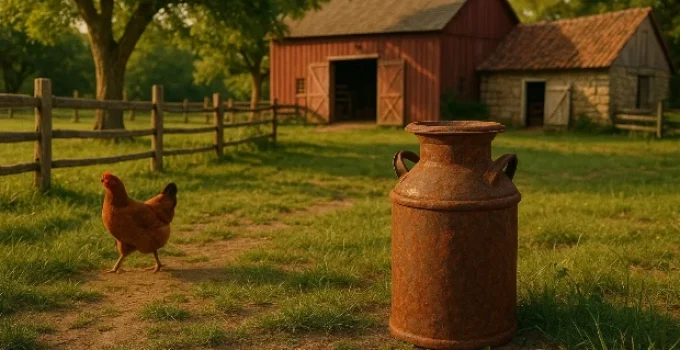Why Does Iron Rust Over Time?
Have you ever left a bike out in the rain and noticed orange spots forming on the frame? That’s rust! But what actually causes iron to rust—and why does it seem to happen faster in some places than others? This article will break down the science of rust, how it’s formed, and what you can do to prevent it.
🔎 Dive Deeper
- What Is Rust, Really?
- What Causes Iron to Rust?
- How Does the Environment Speed Up Rusting?
- How Can Rust Be Prevented?
- Can Rust Be Reversed?
- Why Does It Matter?
- 🎯 Final Thoughts
- 📚 References
What Is Rust, Really?
Rust is the reddish-brown flaky coating you often see on metal objects. It forms when iron reacts with oxygen and water. Chemically, rust is iron oxide (Fe₂O₃ or Fe(OH)₃), which means iron has combined with oxygen and hydrogen from water.
| Type of Material | Reacts to Form | Appearance |
|---|---|---|
| Iron | Iron oxide (rust) | Reddish-brown flakes |
| Copper | Copper carbonate (patina) | Green-blue coating |
| Aluminum | Aluminum oxide | Dull gray surface |
📊 Surprising Fact: The Federal Highway Administration reports that rust costs the American economy over $276 billion per year due to damage and repair needs.
What Causes Iron to Rust?
Rusting is a chemical reaction known as oxidation. For iron to rust, three things must be present:
- Iron (Fe)
- Oxygen (O₂)
- Water (H₂O)
When water touches iron, it helps dissolve oxygen from the air. This oxygen reacts with iron atoms to form iron oxide. Salt, acids, and pollutants can make this reaction happen even faster.
🔬 Saltwater speeds up rusting because salt ions increase the water’s electrical conductivity.
How Does the Environment Speed Up Rusting?
Different environmental conditions affect how quickly iron rusts:
- Humidity: More moisture means more rust.
- Saltwater: Speeds up oxidation—common near oceans.
- Acid Rain: Adds extra ions and causes faster breakdown.
If you leave iron in a dry place, it can stay rust-free for a long time. But in humid or coastal areas, rust can show up in just a few days.
🌍 A NASA study found that spacecraft components made with iron-based materials corrode much faster in high-humidity, coastal locations. (NASA)
How Can Rust Be Prevented?
There are many ways to protect iron from rusting:
- Painting or Coating: Creates a barrier between metal and moisture.
- Galvanization: Coats iron in a protective layer of zinc.
- Stainless Steel: A mix of iron, carbon, and chromium that resists rust.
- Oil or Grease: Blocks water and oxygen contact.
🛡️ The U.S. Department of Energy recommends galvanizing steel used in outdoor environments to prevent rust for decades. (DOE)
Can Rust Be Reversed?
While rust can’t truly be reversed, it can be removed. Here’s how:
- Mechanical Removal: Sanding or wire brushing off the flakes.
- Chemical Rust Removers: Acids like phosphoric acid can dissolve rust.
- Electrolysis: A science-based method that uses electricity to pull rust off iron.
However, once rust eats into the metal, the lost material can’t be fully recovered.
🧪 Researchers at MIT developed a rust-removal system using electrochemical methods that can restore some surfaces without damaging the original metal. (MIT)
Why Does It Matter?
Rust isn’t just about looks—it weakens structures. Rusted bridges, cars, and pipes can collapse, leak, or fail. That’s why scientists and engineers study rust prevention closely in buildings, transportation, and even space equipment.
🏗️ According to the Federal Highway Administration, corrosion has compromised more than 200,000 U.S. bridges, many due to rust. (FHWA)
🎯 Final Thoughts
So, why does iron rust? Iron rusts when it reacts with oxygen and water—a process called oxidation. This chemical change turns strong metal into weak, crumbly flakes. By understanding what causes rust and how to prevent it, we can protect buildings, tools, and even artwork from falling apart over time. Whether you’re a scientist or just curious about that rusty bike in the yard, rust reveals how powerful even simple reactions can be.
📚 References
- 📝 Koch, Gerhard H., Michiel P.H. Brongers, Neil G. Thompson, Y. Paul Virmani, and J. H. Payer. Corrosion Costs and Preventive Strategies in the United States. FHWA-RD-01-156, U.S. Federal Highway Administration, 2002. https://rosap.ntl.bts.gov/view/dot/40697.
- 📝 Mir Chohan, Imran, et al. “Effect of Seawater Salinity, pH, and Temperature on External Corrosion Behavior and Microhardness of Offshore Oil and Gas Pipeline: RSM Modelling and Optimization.” Scientific Reports, vol. 14, no. 16543, 2024, doi:10.1038/s41598-024-67463-2
- 📝 Calle, Luz Marina. Corrosion Control in the Aerospace Industry. NASA, 22 Sept. 2020. NASA Technical Reports Server, https://ntrs.nasa.gov/api/citations/20205007801/downloads/Control%20de%20la%20Corrosi%C3%B3n%20en%20la-English%20Translation-R.pdf.
- 📝 United States Department of Energy. Advanced Conductor Report. Dec. 2023, https://www.energy.gov/sites/default/files/2024-08/Advanced%20Conductor%20Report%20December%202023.pdf.
- 💻 MIT News. “Making Steel with Electricity.” https://news.mit.edu/2024/mit-spinout-boston-metal-makes-steel-with-electricity-0522
- Federal Highway Administration. “Improved Corrosion-Resistant Steel for Highway Bridge Construction.” https://www.fhwa.dot.gov/publications/research/infrastructure/bridge/11062/001.cfm
📌 Learn More About Chemical Reactions
- What Is a Chemical Reaction?🔥20 Real Life Examples That Prove Chemistry Is All Around You
- What Happens If You Mix Baking Soda and Vinegar? 🧪The Science Behind the Fizz
- Is Burning Wood a Chemical Change? 🔥The Science Behind Fire, Ash, and Transformation
- What Makes a Glow Stick Glow?🔥The Cool Chemistry Behind the Glow in the Dark Magic
- What Makes Fireworks Colorful? 🎆 The Chemistry That Lights Up the Sky
